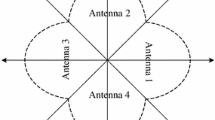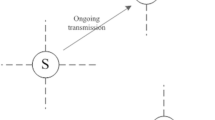Abstract
Hybrid Distributed Coordination Function (HDCF), a modified medium access control protocol of IEEE 802.11 standard, is proposed in this paper to support both smart adaptive array antennas and normal omni-directional antennas simultaneously in one wireless LAN. Omni-directional antennas follow the standard Distributed Coordination Function (DCF) and smart antennas follow the Directional DCF (DDCF). The proposed DDCF is based on Hybrid Virtual Carrier Sense (HVCS) mechanism, which includes Omni-directional Request-To-Send/Clear-To-Send (ORTS/OCTS) hand-shake mechanism and directional data transmission. HDCF is compatible with DCF. When a node transmits in a directional beam, the other nodes can multiplex the physical channel. Hence, HDCF supports Space Division Multiple Access (SDMA). Simulation results show that HDCF can support hybrid antennas effectively and provide much higher network throughput and lower delay and jitter than DCF does.
Similar content being viewed by others
References
IEEE 802.11 WG, Reference number ISO/IEC 8802-11: 1999 (E) IEEE Std. 802.11, 1999 edition. International Standard for Information Technology-Telecommunications and information exchange between systems-Local and metropolitan area networks-Specific Requirements-Part 11: Wireless LAN Medium Access Control (MAC) and Physical Layer (PHY) specifications, 1999.
Y. Ko, V. Shankarkumar, N. H. Vaidya. Medium access control protocols using directional antennas in ad hoc networks. IEEE INFOCOM, Tel Aviv, Israel, March 26–30, 2000, 13–21.
Asis Nasipuri, Shengchun Ye, Robert E. Hiromoto. A MAC protocol for mobile ad hoc networks using directional antennas. IEEE WCNC, Chicago, IL, September 26–29, 2000, 1214–1219.
Srikanth V. Krishnamurthy, Anthony S. Acampora, Michele Zorzi. Polling-based media access protocols for use with smart adaptive array antenna. IEEE/ACM Trans. on Networking, 9(2001)2, 148–161.
Jun Yang, Jiandong Li, Min Sheng. MAC protocol for mobile ad hoc network with smart antennas. IEE Electronics Letters, 39(2003)6, 555–557.
Liqiang Zhao, Changxin Fan. MAC protocol of WLAN using smart adaptive array antennas. Journal of Xidian University, 31(2004)4, 602–607 (in Chinese). 赵力强, 樊昌信. 支持智能自造应阵列天线的无线局域网媒体接入控制协议. 西安电子科技大学学报, 31(2004)4, 602–607.
G. Bianchi. Performance analysis of the IEEE 802.11 distributed coordination function. IEEE J. on SAC, 18 (2000)3, 535–547.
E. Ziouva, T. Antonakopoulos. CSMA/CA performance under high traffic conditions: throughput and delay analysis. Comp. Commun., 25(2002)2, 313–321.
P. Chatzimisios, A. C. Boucouvalas, V. Vitsas. IEEE 802.11 packet delay-a finite retry limit analysis. IEEE Globecom’2003, Wireless Communications Symposium, San Francisco, USA, 2003, Session WC24.
IEEE 802.11 WG, Draft Supplement to Standard for Telecommunications and Information Exchange Between Systems-LAN/MAN Specific Requirements-Part 11: Wireless Medium Access Control (MAC) and Physical Layer (PHY) Specifications: Medium Access Control (MAC) Enhancements for Quality of Service (QoS), IEEE 802.11e/Draft 4.2, Feb. 2003.
Yang Xiao. A simple and effective priority scheme for IEEE 802.11. IEEE Communications Letters, 7(2003)2, 70–72.
Liqiang Zhao, Changxin Fan. Enhancement of QoS differentiation over IEEE 802.11 WLAN. IEEE Communications Letters, 8(2004)8, 494–496.
IEEE WG, 802.11b, Part 11: Wireless LAN Medium Access Control (MAC) and Physical Layer (PHY) Specifications: High-Speed Physical Layer Extension in the 2.4GHz Band, 1999.
Author information
Authors and Affiliations
Corresponding author
Additional information
Communication author: Zhao Liqiang, born in 1971, male, Ph.D., associate professor. State Key Laboratory of Integrated Services Networks, Xidian University, Xi’an 710071, China.
About this article
Cite this article
Zhao, L., Zhang, H. & Liu, Y. A MAC protocol to support hybrid antennas in a wireless LAN. J. of Electron.(China) 24, 309–315 (2007). https://doi.org/10.1007/s11767-005-0213-8
Received:
Revised:
Published:
Issue Date:
DOI: https://doi.org/10.1007/s11767-005-0213-8
Key words
- Wireless LAN
- Smart adaptive array antennas
- Medium Access Control (MAC)
- Space Division Multiple Access (SDMA)




